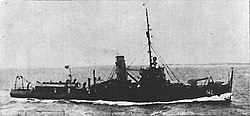Nautilus (ship, 1919)
|
||||||||||||||||||||
|
||||||||||||||||||||
|
||||||||||||||||||||
|
||||||||||||||||||||
The Nautilus was a minesweeper already commissioned by the Imperial Navy , but only completed in 1919 with the designation M 81 , one of 36 minesweeper- type boats of 1916 that were still used by the Kriegsmarine during World War II .
Construction and technical data
The boat was on the 1917 Seebeck Shipyard in Geestemünde at the Unterweser laid down on , but ran only after the end of the war on September 8, 1919 from the pile and was supported by the on 13 October 1919 the Navy commissioned.
With a length of 56.0 m in the waterline or 59.3 m over all, a width of 7.40 m and a maximum draft of 2.23 m , the boat displaced 515 t standard and a maximum of 553 t. Two coal-fired marine boilers and two standing triple expansion steam engines with a total of 1600 hp enabled a top speed of 16 knots via two shafts and screws . With the bunker supply of 120 tons of coal at a cruising speed of 14 knots, an action radius of 2000 nautical miles was given. The armament consisted of a 10.5-cm L / 45 C / 06 Sk and a 20-mm L / 65 C / 38 anti-aircraft gun . In 1943 a second 20 mm anti-aircraft gun was added.
history
Imperial Navy
The boat was initially used as a fleet tender . From March 11, 1929, under the new name Nautilus , it was used as a test boat at the Sperrversuchskommando (SVK) of the Kriegsmarine in Kiel , where the development and testing of sea mines , detonators and clearing devices was concerned.
Navy
During the German invasion of Poland on September 1, 1939, the Nautilus was , together with the four other test boats of the Sperrversuchskommando ( Arkona , Otto Braun , Pelikan and Sundevall ), part of the naval forces, which was led by Captain Friedrich Ruge , the leader of the minesweepers East (FdMO), carried out mine search and security tasks in the Gdańsk Bay . On September 19, the boat was then - together with the boats M 3 , M 4 , Nettelbeck , Fuchs , Otto Braun , Pelikan , Arkona , Sundevall and Drache and the old ship of the line Schleswig-Holstein - at the bombardment of the Polish positions near Gdynia ( Oxhöfter Kämpe, Ostrowogrund and Hexengrund), which could only then be conquered by army soldiers.
At the Weser Exercise Company , the occupation of Denmark and Norway , the Nautilus belonged to Warship Group 7 under Captain Gustav Kleikamp on the Schleswig-Holstein , which occupied the Danish ports of Nyborg on Funen and Korsør on Zealand in the early morning of April 9, 1940 . In addition to the Schleswig-Holstein and the Nautilus , this group consisted of the test boats Claus von Bevern and Pelikan , the Campinas (4541 GRT) and Cordoba (4611 GRT) transporters, two tugs and the BSO school flotilla with six fish steamers converted into outpost boats . The three test boats transported a company from Infantry Regiment 326 ( 198th Infantry Division ) and a small radio relay from Intelligence Department 235 to Nyborg, which occupied the port there.
Afterwards the boat provided escort service in the Denmark-Southern Norway area. It escaped on April 19, 1940, when the three cargo ships Moltekefels (7863 BRT), Hanau (5892 BRT) and Porto Alegre (6105 BRT) returned to Germany, in the Skagerrak south of the Oslofjord at 58 ° 18 ′ N , 10 ° 48 ′ O a torpedo attack by the British submarine HMS Triad when all four torpedoes fired missed their target. The British commander, LtCdr Oddie, believed the German speedboat escort ship Tsingtao and four anti-submarine - Trawler in front of you.
The boat was converted back to a minesweeper on October 1, 1940, was given the designation M 581 and then served as a torpedo catcher for the detachment squad until the end of the war .
post war period
At the end of the war the boat became allied spoils of war and was then used in the German mine clearance service with the 40th minesweeping flotilla within the 3rd mine clearance division stationed in Copenhagen until it was scrapped in 1950.
Footnotes
- ↑ Ruge on the leader boat T 196 also commands the four fleet attendants F 7 , F 8 , F 9 and F 10 , the 1st minesweeping flotilla and the 3rd clearing boat flotilla ( http://www.wlb-stuttgart.de/seekrieg/39 -08.htm )
- ↑ http://www.wlb-stuttgart.de/seekrieg/39-08.htm
- ↑ Historia Gdyni , section Wybuch Wojny - Okupacja - Wyzwolenie , accessed on September 27, 2011.
- ↑ http://www.wlb-stuttgart.de/seekrieg/40-04.htm
- ↑ Oliver Krauss: Armament and armament testing in German naval history with special consideration of the Torpedoversuchsanstalt (TVA). Dissertation, Christian-Albrechts-Universität Kiel, 2006, p. 426
- ↑ http://www.uboat.net/allies/commanders/1866.html
- ↑ http://www.historisches-marinearchiv.de/projekte/asa/ausgabe.php?where_value=574
- ↑ http://www.wlb-stuttgart.de/seekrieg/minen/mrdiv3-frames.htm
Web links
- http://www.navypedia.org/ships/germany/ger_mine_m57.htm
- http://www.german-navy.de/hochseeflotte/ships/minehunters/m1916/index.html
literature
- Erich Gröner : The German warships 1815-1945, Vol. 2: Torpedo boats, destroyers, speed boats, minesweepers, mine clearance boats , Munich, 1983
